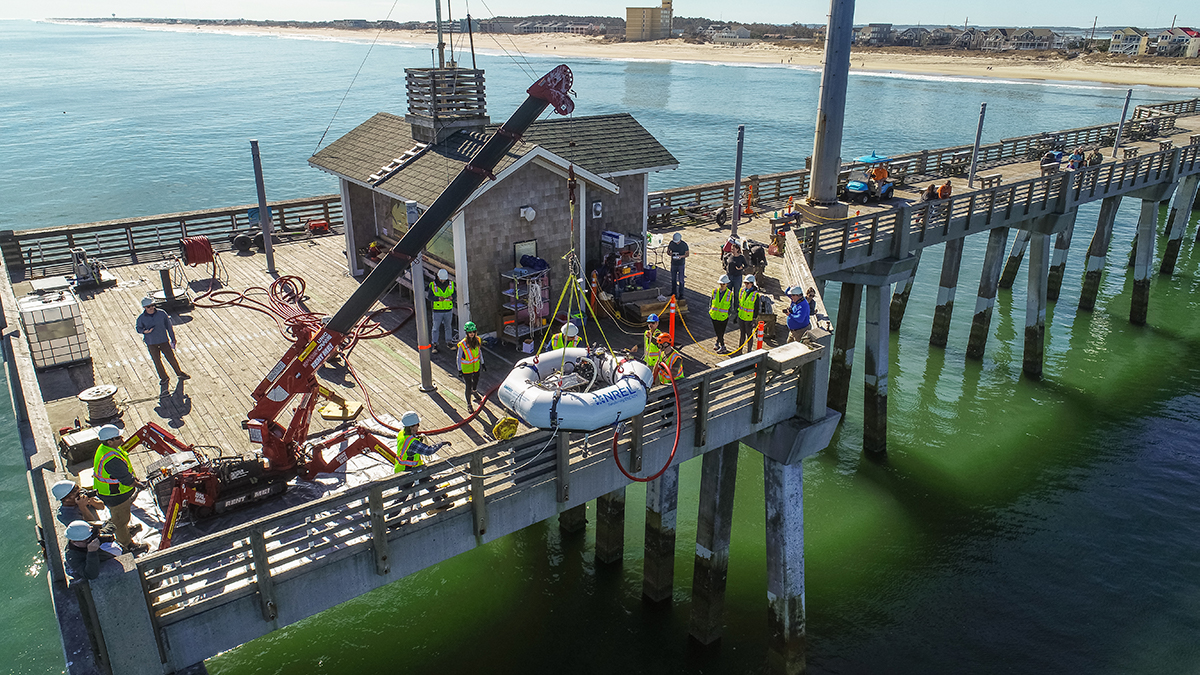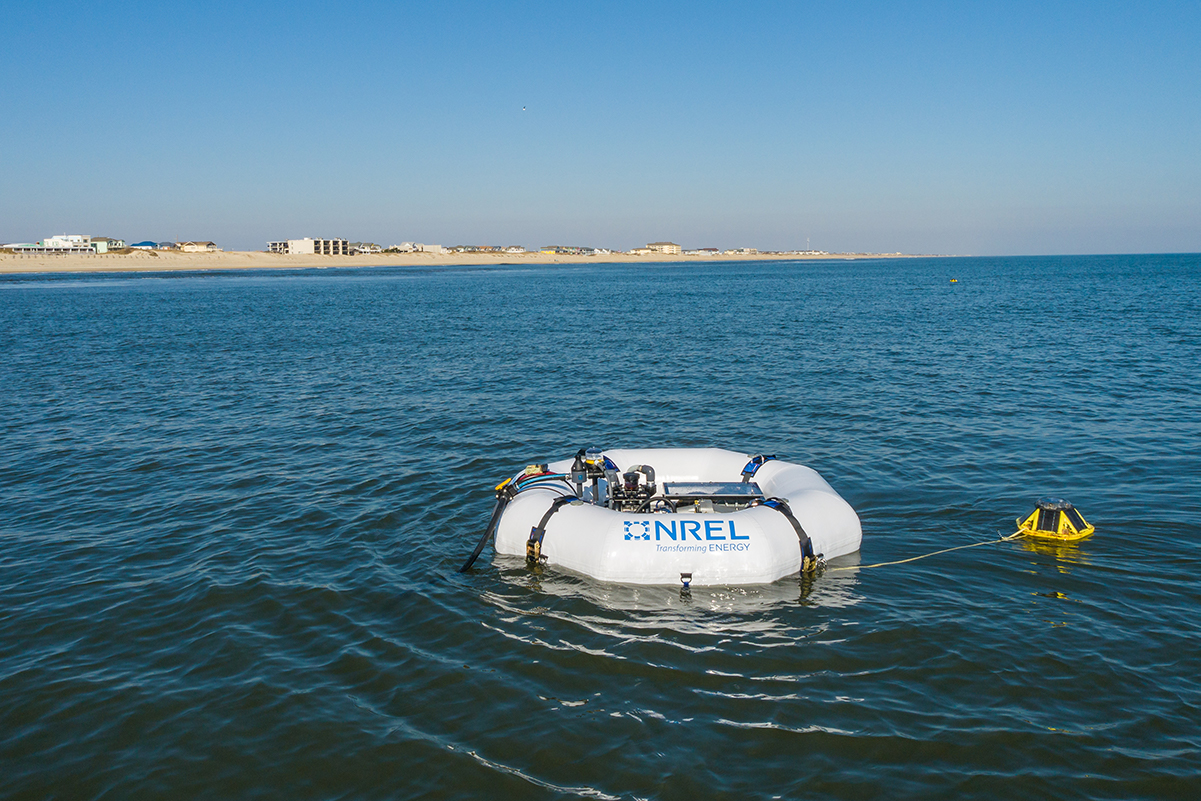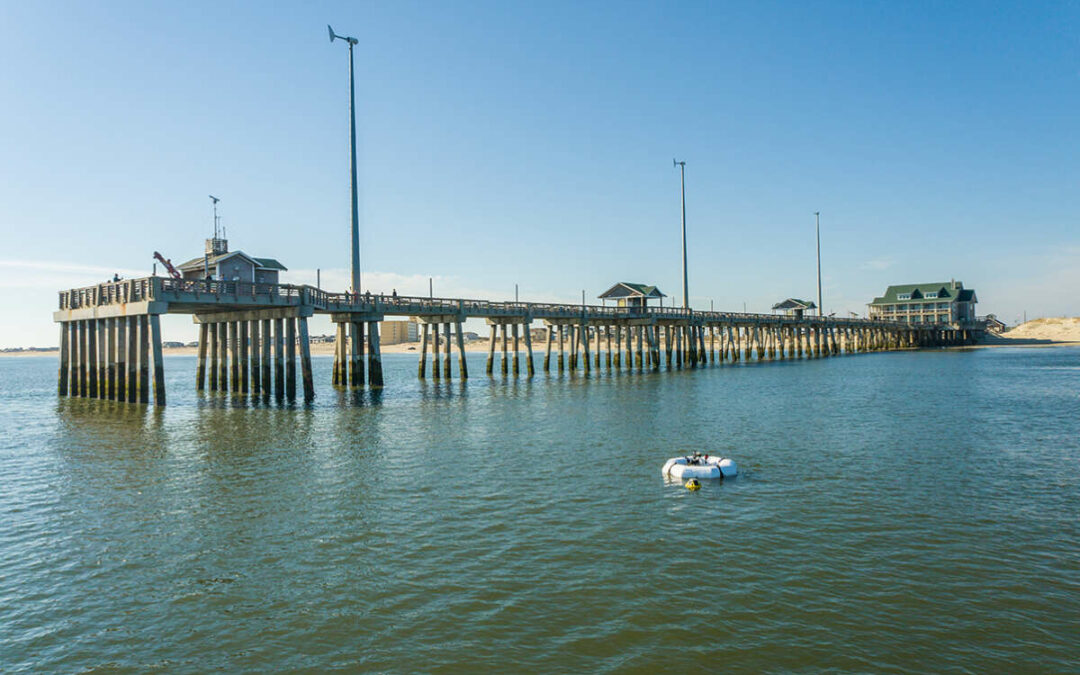It’s the final countdown. Showtime. The home stretch. The finish line is near. However you’d like to phrase it, the Waves to Water Prize DRINK Finale is just around the corner. In just one month, the remaining four teams will arrive in the Outer Banks to put their devices to the test.
Funded by the U.S. Department of Energy (DOE) Water Power Technologies Office (WPTO) and administered by the National Renewable Energy Laboratory (NREL), the Waves to Water Prize is a five-stage, $3.3 million competition. The prize kicked off in mid-2019 and challenged competitors to design, refine, and build their wave-powered desalination devices in hopes of providing better access to clean drinking water for remote coastal communities and for disaster relief efforts.
As if the innovation and potential technological advances weren’t exciting enough, CSI and Jennette’s Pier were selected to host the DRINK Finale and have been gearing up for the event ever since.

Before the HERO WEC could begin pumping water back to the pier to be desalinated, the device first had to be lifted over the side of the pier. The operation called for all hands on deck.
NREL, the Coastal Studies Institute, and Jennette’s Pier bring different aspects to this project. “The National Renewable Energy Laboratory has been developing renewable energy technology for decades,” said Scott Jenne, a research engineer at NREL who is the principal investigator of the competition. “The Coastal Studies Institute has a breadth of experience deploying technologies in the ocean and recovering those systems, really understanding how to develop systems that can survive the harsh conditions of the ocean,” he said. “Finally, Jennette’s Pier provides a great location for us to test these systems in a way that the public can access them, making for a great outreach event.”
In preparation for the DRINK Finale, folks from CSI, Jennette’s Pier, NREL, and DOE have spent hundreds, maybe even thousands, of hours coordinating the event. Most notably, two test deployments have occurred in the last year, the first of which was a simple buoy deployed last spring.
The second test deployment occurred in February and was much more involved. A team of NREL engineers, led by Jenne, developed their own hydraulic and electric reverse osmosis wave energy converter (HERO WEC) to pump seawater to the pier. A reverse osmosis unit and large tank were placed on the end of the pier so that the water could be desalinated and then collected for quality testing. Ocean water at Jennette’s Pier usually has a salinity of 28- 32 parts per thousand (ppt), but to be considered drinkable by the World Health Organization, the desalinated water must have a reading of less than 1 ppt. Even at that number though, the water would still taste salty to humans. So, the cleaner, the better!
Through both trial deployments, the planning teams had their work cut out for them. Not only did they have to wait for good weather and fair seas, but they had to hoist the test articles with a crane over the side of the pier and into the water. Then, divers and personnel in small watercraft towed the device to its designated anchor site. All of this was done in reverse once it was time to pull the article out. During the deployment and retrieval processes, additional team members watched for vessels and marine mammals that may come too close to the test area, and still others talked to curious bystanders on the pier. In the end, each of the test runs helped the crew to establish and refine the protocols necessary for smooth deployments during the DRINK Finale.

The HERO WEC was anchored within the test hour for about 24 hours in February. It was visible to onlookers on both the beach and the pier, and the same will be said for the four devices deployed in April.
“For the Waves to Water Prize, we are using HERO WEC as a system to help understand how to set up the prize and provide the divers an opportunity to install this type of system before the actual event,” said Jenne. “This allows us to ensure that the event goes smoothly and fairly for all competitors.”
Now that most logistics have been finalized, the four competing teams will arrive in late March to assemble their devices and pitch their designs to investors. Then they will anxiously await a to-be-determined five-day, good-weather window for their devices to finally be deployed at Jennette’s Pier.
Members of the public will be able to see the devices from the beach and have the opportunity to watch them be deployed from the pier. Additionally, staff from CSI, Jennette’s Pier, NREL, and DOE will be at the pier hosting public events and school groups for ocean-oriented activities most days in April. For the most up-to-date information about Waves to Water Prize events happening locally, be sure to follow CSI on Twitter, Instagram, and Facebook.
This story was first published on March 10, 2022, and featured in the Winter 2022 issue of ECU Integrated Coastal Program’s quarterly newsletter, CoastLines.



 Based at the Coastal Studies Institute (CSI), the North Carolina Renewable Ocean Energy Program (NCROEP) advances inter-disciplinary marine energy solutions across UNC System partner colleges of engineering at NC State University, UNC Charlotte, and NC A&T University. Click on the links below for more information.
Based at the Coastal Studies Institute (CSI), the North Carolina Renewable Ocean Energy Program (NCROEP) advances inter-disciplinary marine energy solutions across UNC System partner colleges of engineering at NC State University, UNC Charlotte, and NC A&T University. Click on the links below for more information. ECU's Integrated Coastal Programs (ECU ICP) is a leader in coastal and marine research, education, and engagement. ECU ICP includes the Coastal Studies Institute, ECU's Department of Coastal Studies, and ECU Diving and Water Safety.
ECU's Integrated Coastal Programs (ECU ICP) is a leader in coastal and marine research, education, and engagement. ECU ICP includes the Coastal Studies Institute, ECU's Department of Coastal Studies, and ECU Diving and Water Safety. The ECU Outer Banks campus is home to the Coastal Studies Institute.
The ECU Outer Banks campus is home to the Coastal Studies Institute.

